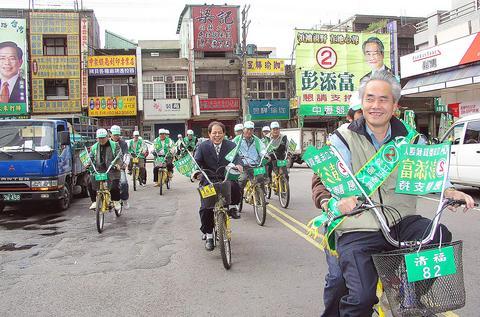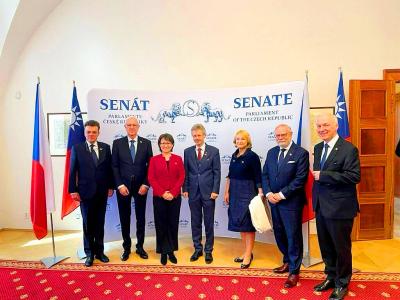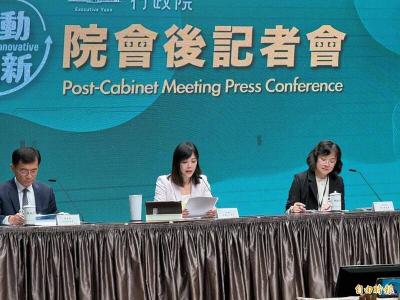Each of Taiwan's 31 electoral districts has its own special characteristics. Taoyuan County, which elects 13 members of the Legislature, is the nation's biggest electorate. It is also one of its most complex.
Home to 1,800,000 people, Taoyuan County has long been divided into the North, focused on Taoyuan city, and the South, which has Chungli city as its key city. The North is mainly Hoklo while the South is predominantly Hakka. In addition, numerous military bases and large numbers of military villages throughout the county mean that many Mainlanders also live in Taoyuan.

PHOTO: LU SHU-CHING, TAIPEI TIMES
In addition to the county's some 40,000 Aboriginal people, about one-half of the population is Hoklo, while one-third is Hakka and about one-sixth (or a bit more) is Mainlander.
In the authoritarian period, this ethnic division led to strong competition between a Hoklo and a Hakka faction. The divisions became so bad that the two sides agreed to a rotation of offices.
In addition to these ethnic elements, Taoyuan County also has a coastal region and a mountainous region. This interplay of ethnic and geographical differences makes the county extremely complex for any political party trying to win control. Yet, in the legislative election, Taoyuan elects over seven percent of the seats. Thus, Taoyuan County cannot be ignored.
Over the years, Taoyuan has tended to be a pan-blue citadel. In the March 2004 presidential election, Chinese Nationalist Party (KMT) Chairman Lien Chan (
People from all sides of the political spectrum agree about two key aspects of the current legislative campaign in Taoyuan.
First, all sides have nominated too many candidates. Nineteen of the twenty-eight candidates running for the thirteen positions are nominees of the four major parties.
In addition, there are at least one or two reasonably powerful non-partisans. Secondly, no party (with the partial exception of the KMT) has implemented a system of vote allocation.
For this election the DPP has nominated seven candidates, even though the presidential vote would suggest six candidates would have been more appropriate. Taoyuan has one seat guaranteed for a woman, and so the DPP added a woman to go with the six seats won by males in the primary election within the DPP.
However, this method of choosing candidates led to the selection of only three from the north -- the heartland of DPP support in Taoyuan -- and the nomination of four candidates in the south, three of whom are Hakka.
Into this mix the Taiwan Solidarity Union (TSU) has now nominated two candidates. Most believe only one, Huang Tsung-yuan (
The pan-blues also have nominated too many candidates. The KMT originally nominated six candidates, though a seventh, actually a member of the New Party, has come in under the KMT banner. The KMT nominations seem to have considered geographical origins more carefully than the DPP.
The geographical distribution has meant that the KMT has ordered each of the township party headquarters to help a specific candidate. This is the only vote allocation so far decreed in Taoyuan, but everyone (including KMT candidates) agrees that it is next to worthless.
Furthermore, the KMT votes in the Huang Fu-hsing (黃復興) Party Headquarters from retired servicemen have all been allocated to Chu Feng-chih (朱鳳芝), a female Mainlander KMT nominee. All other KMT candidates have complained about this distribution, especially as all public opinion polls have Chu in either first or second place, with almost twice as many votes as the third and fourth-ranked candidates. In terms of gender, two of the six original KMT candidates are women.
The PFP has nominated three candidates, bringing the total number of pan-blue nominees to ten. Together with the KMT's Chu, Sun Ta-chien (
With so many candidates running, the margin between winners and losers will be quite small. This means that successful vote allocation could improve a party's result by one or two seats, but it also means that mistakes in vote allocation could mean that a certain winner could lose.
Thus, with the complexity of the election, its uncertainty, and the lateness in the campaign, probably no party will attempt to implement a vote allocation strategy in Taoyuan County. The likelihood is that the pan-greens will keep their five seats and possibly increase their seats to six. But the leading pan-blue candidates will do well. In addition to Sun and Chu, Wu Chih-yang (
Bruce Jacobs is Professor of Asian Languages and Studies and Director of the Taiwan Research Unit at Monash University in Melbourne, Australia.

The Mainland Affairs Council (MAC) today condemned the Chinese Communist Party (CCP) after the Czech officials confirmed that Chinese agents had surveilled Vice President Hsiao Bi-khim (蕭美琴) during her visit to Prague in March last year. Czech Military Intelligence director Petr Bartovsky yesterday said that Chinese operatives had attempted to create the conditions to carry out a demonstrative incident involving Hsiao, going as far as to plan a collision with her car. Hsiao was vice president-elect at the time. The MAC said that it has requested an explanation and demanded a public apology from Beijing. The CCP has repeatedly ignored the desires

Many Chinese spouses required to submit proof of having renounced their Chinese household registration have either completed the process or provided affidavits ahead of the June 30 deadline, the Mainland Affairs Council (MAC) said on Thursday. Of the 12,146 people required to submit the proof, 5,534 had done so as of Wednesday, MAC deputy head and spokesperson Liang Wen-chieh (梁文傑) said. Another 2,572 people who met conditions for exemption or deferral from submitting proof of deregistration — such as those with serious illnesses or injuries — have submitted affidavits instead, he said. “As long as individuals are willing to cooperate with the legal

The Ma-anshan Nuclear Power Plant’s license has expired and it cannot simply be restarted, the Executive Yuan said today, ahead of national debates on the nuclear power referendum. The No. 2 reactor at the Ma-anshan Nuclear Power Plant in Pingtung County was disconnected from the nation’s power grid and completely shut down on May 17, the day its license expired. The government would prioritize people’s safety and conduct necessary evaluations and checks if there is a need to extend the service life of the reactor, Executive Yuan spokeswoman Michelle Lee (李慧芝) told a news conference. Lee said that the referendum would read: “Do

Taiwan's Vice President Hsiao Bi-khim (蕭美琴) said Saturday that she would not be intimidated by the Chinese Communist Party (CCP), following reports that Chinese agents planned to ram her car during a visit to the Czech Republic last year. "I had a great visit to Prague & thank the Czech authorities for their hospitality & ensuring my safety," Hsiao said on social media platform X. "The CCP's unlawful activities will NOT intimidate me from voicing Taiwan's interests in the international community," she wrote. Hsiao visited the Czech Republic on March 18 last year as vice president-elect and met with Czech Senate leadership, including